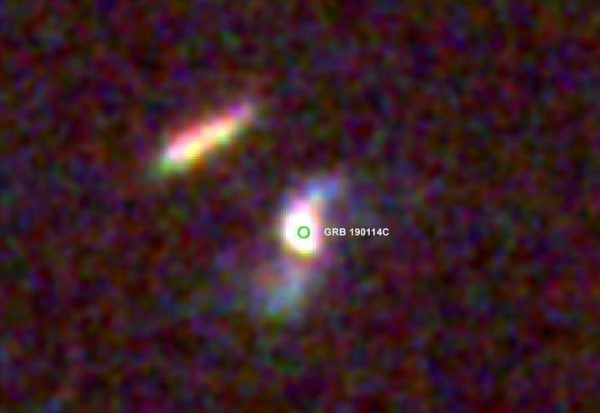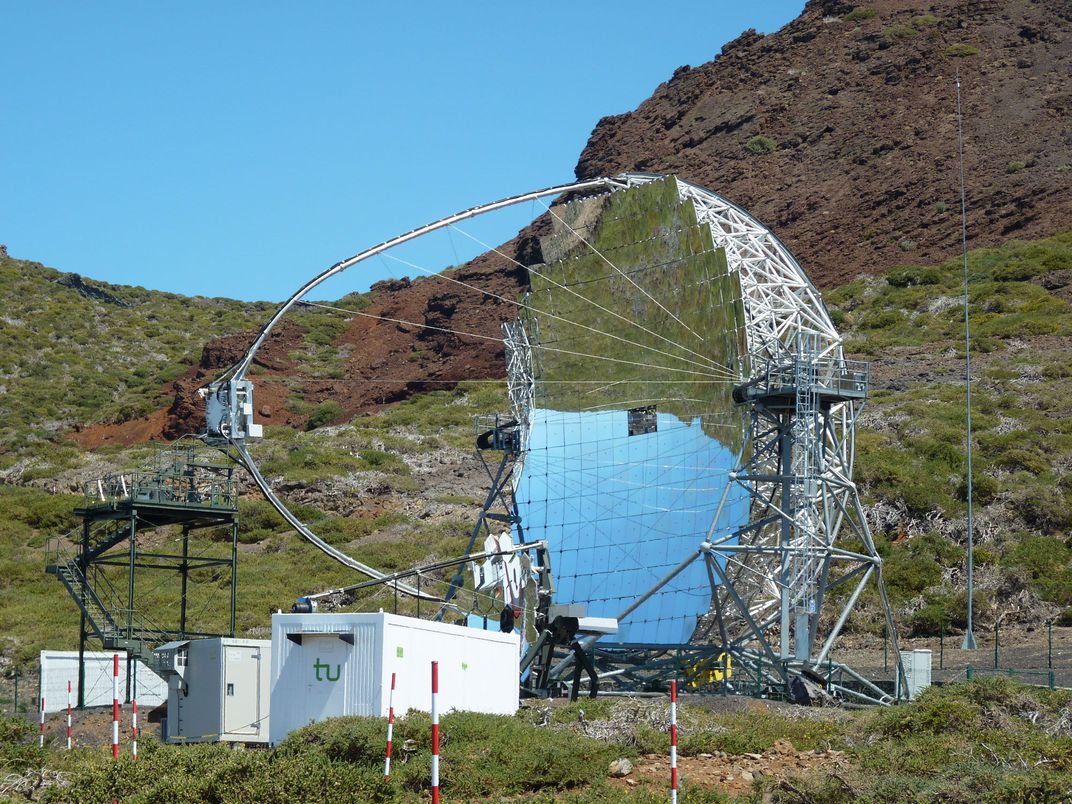Astronomers Detect Record-Breaking Gamma Ray Bursts From Colossal Explosion in Space – Smithsonian
On the night of January 14, 2019, astronomer Razmik Mirzoyan got a call at his home in Germany. The observers on shift at the Major Atmospheric Gamma Imaging Cherenkov Telescope (MAGIC) in the Canary Islands were on the other line. Alerted by two space telescopes—the Neil Gehrels Swift Observatory and Fermi Gamma-ray Space Telescope—the two MAGIC telescopes were pointed in the direction of emissions from an immensely powerful cosmic outburst that were arriving at Earth. Within the first 20 minutes of observation, the telescopes detected a strong and increasing signal that seemed to be from a gamma ray burst, the most energetic type of explosion known to occur in the universe.
Mirzoyan told the observers to keep measuring.
That night Mirzoyan, who is a researcher at the Max Planck Institute for Physics in Munich, dashed off a short note on the Astronomer’s Telegram, hoping other telescope operators would turn their machines toward the signal. He described how the MAGIC telescopes saw the highest energy emissions ever measured from a gamma ray burst (GRB), with photon energies of up to 1,000 billion electronvolts, or 1 teraelectronvolt (TeV). These were also the first observations of a gamma ray burst (GRB) by MAGIC or any other ground-based telescope.
Without any sleep, Mirzoyan headed to Arizona the next day to celebrate the inauguration of a next-generation gamma ray telescope at Whipple Observatory. By the time he arrived, word had spread about the detection. Everyone in the room was eager to shake Mirzoyan’s hand and congratulate the MAGIC team, says Jamie Holder, an astronomer from the University of Delaware who was there. “Almost every conversation I had that week centered around the discovery,” he says. “What have they seen? What does it mean? Can we see it, too?”

A few months later, another group of scientists went through their archived observations and found that they, too, detected GRB emissions from the ground. In July 2018, the High Energy Stereoscopic System (HESS) array of telescopes in Namibia detected the faint afterglow emission of another GRB 10 hours after the initial explosion. Even after nearly half a day, the afterglow still had photons with energies of 100 to 440 gigaelectronvolts. Both teams published their results in separate papers the journal Nature today.
“These ground-based telescopes have been operating for more than a decade, and GRBs have been one of their main targets, and this is the first time they actually detected them,” says astrophysicist Bing Zhang of University of Nevada, Las Vegas, who was not involved in the research but wrote an editorial about the new papers for Nature.
Gamma rays are the highest-energy form of radiation, with wavelengths that can be smaller than the nucleus of an atom. (Radio waves, for comparison, have wavelengths ranging between about a millimeter to hundreds of kilometers.) Gamma ray bursts are phenomena that occur in distant galaxies, and astronomers believe the violent outbursts can happen when a massive star dies and collapses in on itself, resulting in a supernova. In one second, a GRB can release as much energy as the sun will produce in its lifetime. The light arrives at Earth as a prompt “flash” of gamma rays. This flash is associated with the highly energetic jets of plasma that form as the core of a dying star becomes a black hole or a neutron star, Holder says, and the afterglow that follows comes from the shock waves as this jet plows into in the surrounding region.
Compared to space-based telescopes, which have been observing GRBs for years, ground-based telescopes have much larger surfaces for detection, but they have the disadvantage of being beneath Earth’s atmosphere, which absorbs gamma radiation. Until now, detecting a GRB from Earth’s surface has proven elusive.
“Now we know that it is possible to observe GRBs from the ground, to high energies, long after the burst occurred,” says Holder. “This will allow us to tune our search strategies to discover more bursts, and to study them as a population.”

Both of the GRBs that were observed are believed to be the result of supernovas. The burst seen by MAGIC, called GRB 190114C, came from about 4.5 billion light-years away, and the one seen by HESS, named GRB 180720B, came from 6 billion light-years away.
The observations show that GRBs produce even more energetic emissions than previously known. Konstancja Satalecka, a scientist at the German Electron Synchrotron (DESY) who was part of the MAGIC collaboration, said in a statement that researchers were missing about half of the energy budget of GRBs until now. “Our measurements show that the energy released in very-high-energy gamma-rays is comparable to the amount radiated at all lower energies taken together,” she said. “That is remarkable!”
Now scientists also know that GRBs are able to accelerate particles within the explosion ejecta. After ruling out other theoretical explanations, both teams of scientists have suggested that the very-high-energy gamma ray photons had been scattered by electrons while traveling through space, boosting their energy in a process known as inverse Compton scattering.
“These results are very exciting,” Dan Hooper, head of the Theoretical Astrophysics Group at the Fermi National Accelerator Laboratory, says in an email. “Astrophysicists have long expected gamma-ray bursts to emit photons in this energy range (the teraelectronvolt range), but until now this had never been observed.” Hooper was also surprised by how high-energy emissions were able to persist in the long afterglow of GRB 180720B. “Considering that the initial burst is measured in tens of seconds, a 10-hour afterglow at such high energies is a remarkable feature.”
The findings from MAGIC and HESS have scientists even more excited for the next generation of gamma ray telescopes. The new telescope that Mirzoyan was celebrating in Arizona is a prototype for the Cherenkov Telescope Array (CTA) Observatory, which will consist of 118 telescopes being built in Chile and the Canary Islands. Once in operation, these telescopes will be able to detect gamma rays in the range of 20 GeV to 300 TeV, with about ten times better sensitivity than other current observatories.
Edna Ruiz-Velasco, a researcher at the Max Planck Institute for Nuclear Physics in Heidelberg, Germany, who is part of the HESS team, says these new observatories will be able to detect GRBs several days after the initial burst, covering longer timescales of the total emissions. Better detections might also help scientists investigate the possible connection between gamma ray bursts and gravitational waves, or the ripples in spacetime that scientists have only recently observed directly.
After decades of waiting, Mirzoyan says he thinks that observations of GRBs from the ground will become much more routine. Already, the HESS team posted another notice on the Astronomer’s Telegram that they spotted another burst in August. With so much more data pouring in, astronomers may soon unravel the mysteries of the most immense explosions in the universe.






